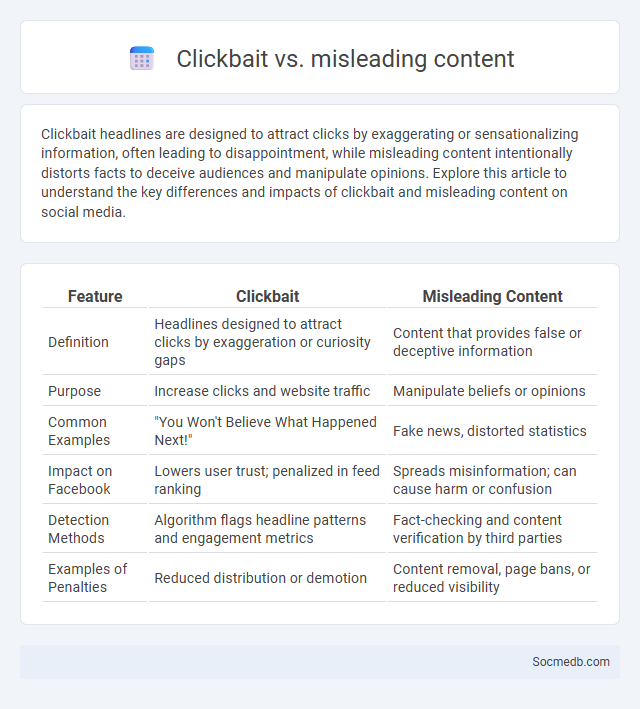
Photo illustration: Clickbait vs misleading content
Clickbait headlines are designed to attract clicks by exaggerating or sensationalizing information, often leading to disappointment, while misleading content intentionally distorts facts to deceive audiences and manipulate opinions. Explore this article to understand the key differences and impacts of clickbait and misleading content on social media.
Table of Comparison
| Feature | Clickbait | Misleading Content |
|---|---|---|
| Definition | Headlines designed to attract clicks by exaggeration or curiosity gaps | Content that provides false or deceptive information |
| Purpose | Increase clicks and website traffic | Manipulate beliefs or opinions |
| Common Examples | "You Won't Believe What Happened Next!" | Fake news, distorted statistics |
| Impact on Facebook | Lowers user trust; penalized in feed ranking | Spreads misinformation; can cause harm or confusion |
| Detection Methods | Algorithm flags headline patterns and engagement metrics | Fact-checking and content verification by third parties |
| Examples of Penalties | Reduced distribution or demotion | Content removal, page bans, or reduced visibility |
Understanding Clickbait: Definition and Features
Clickbait refers to content designed to attract clicks by using sensationalized headlines or misleading information that exaggerates the actual content. Key features include emotional triggers, curiosity gaps, and vague or exaggerated language that entice users to engage without delivering substantive value. Effective identification of clickbait helps users navigate social media platforms more critically and avoid misinformation.
What Constitutes Misleading Content?
Misleading content on social media includes false information, distorted facts, and manipulated images or videos designed to deceive viewers. This type of content often exploits emotions, spreading rumors or fake news that can harm public trust and misinform audiences. Understanding these tactics helps you critically evaluate the authenticity of posts and protect yourself from being misled.
Key Differences Between Clickbait and Misleading Content
Clickbait uses sensational headlines designed to grab Your attention and boost clicks, often exaggerating or distorting the content without necessarily being false. Misleading content deliberately manipulates facts or context to deceive viewers, sometimes spreading misinformation or disinformation. Understanding these key differences helps You critically evaluate social media posts and avoid falling for deceptive strategies.
Common Techniques Used in Clickbait
Clickbait often leverages sensational headlines, exaggerated claims, and emotionally charged language to capture Your attention quickly. Techniques include using curiosity gaps by posing questions or leaving information incomplete, prompting users to click to satisfy their intrigue. Visual elements like striking images or thumbnails combined with urgent calls to action further enhance engagement rates on social media platforms.
How Misleading Content Manipulates Readers
Misleading content on social media manipulates readers by exploiting cognitive biases and emotional triggers to distort perceptions and spread misinformation. Algorithms amplify sensational or emotionally charged posts, increasing the visibility of false or deceptive narratives that shape public opinion. This manipulation undermines trust in credible sources and fosters polarization by reinforcing echo chambers and confirmation bias.
Overlapping Tactics: Where Clickbait Meets Misleading Content
Clickbait tactics often overlap with misleading content by exploiting sensational headlines and false promises to drive higher engagement on social media platforms. This strategy manipulates user attention algorithms, resulting in increased shares and clicks while compromising content authenticity. Awareness of these overlaps helps You critically evaluate information and avoid falling victim to deceptive online practices.
Impact of Clickbait on Audience Trust
Clickbait headlines can significantly damage your audience trust by creating false expectations and leading to disappointment when the content fails to deliver. This practice reduces long-term engagement as users become skeptical of the credibility of social media sources. Maintaining transparency and delivering value is essential for sustaining a loyal and trusting audience.
Consequences of Spreading Misleading Information
Spreading misleading information on social media can lead to widespread misinformation, causing confusion and damaging public trust. Your credibility may suffer as falsehoods spread quickly, influencing opinions and decision-making processes negatively. Misleading content also fuels polarization and can result in harmful real-world consequences, such as health risks or social unrest.
Strategies to Identify and Avoid Clickbait and Misleading Content
Effective strategies to identify and avoid clickbait and misleading content include analyzing headlines for exaggerated claims or sensational language commonly used to provoke clicks. Users should verify information by cross-referencing credible sources such as reputable news outlets and fact-checking organizations like Snopes and FactCheck.org. Employing browser extensions and apps designed to detect fake news and misleading links enhances protection against deceptive social media posts.
Promoting Ethical Content Creation Practices
Promoting ethical content creation practices on social media involves transparency, accuracy, and respect for intellectual property rights to build trust among audiences. Content creators should prioritize authenticity by avoiding misinformation, plagiarism, and offensive material, fostering a positive online environment. Platforms like Facebook, Instagram, and TikTok increasingly implement guidelines and AI tools to detect and reduce harmful or misleading content, supporting responsible digital communication.
 socmedb.com
socmedb.com